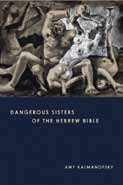Sisters as Destabilizing Figures
In Dangerous Sisters of the Hebrew Bible (Fortress Press, $24), Rabbi Amy Kalmanofsky presents a fresh perspective on the activity of women in the Bible. She contends the role that women play specifically as sisters lends women power, and often drives the action, even while a patriarchal order flourishes.
Kalmanofsky points out that there are a number of types of sisters in the Hebrew Bible. There are sister dyads like Rachel and Leah, the wives of Jacob who vie for his attentions. There are sisters linked in incestuous narratives, one example being the daughters of Lot who, with no other men to continue their line trick and seduce their own father. And there are “sisterhoods” of women not related by blood, who play a cooperative or collective role. Kalmanofsky highlights here the “daughters of the Land” whom Dinah goes out to visit — an excursion which leads to her rape by Shechem. Each of these events provides an important fulcrum for a turn in historical events or transitions in the Bible.
A phenomenon largely overlooked by scholars, it is precisely sisters’ marginal status in the family that makes them instrumental at a point of transition or crisis. At first coming under the jurisdiction of their fathers and brothers, they marry out of the natal family, creating a natural tension between a sister’s birth family allegiance and the interests of her marital family. Unmarried sisters are also a critical point of contact with the outside world, since they are available for marriage or to form alliances with other women. They may also (in the Bible’s view) attract illicit sexual activity.
There are, according to this perspective, “ideal” sisters and “dangerous” sisters. “Ideal” sisters cooperate, support the existing social order and are not (at least while unmarried) sexualized. “Dangerous” sisters are those who “go out” — as the Bible often puts it — to act as independent agents. They may also be objects of desire, leading to the threat of incest or illicit marriage. “Dangerous” sisters destabilize the current order, and though this is dangerous it is not always undesirable. In some cases, the action of a sister may serve primarily to highlight a patriarch’s weakness and provide a cautionary tale. Take the story of Dina, whose interaction with the people of the land — on her own initiative — attracts the sexual attention of an undesirable outsider, endangering Jacob and the clan. However, in other stories, the destabilizing action of a “dangerous” woman may also usher in the next leader and the new chosen order. Look at Rachel and Leah, whose joint decision to back Jacob in his plan to escape Laban endangers Laban’s patriarchal status. To the patriarchal order they were born into, they are a danger — indeed, in shifting power from their natal to their marital family, they help raise Jacob to the status of patriarch in his own right.
Marriage is an important engine driving change. Kalmanofsky’s “dangerous.” sisterhoods raise the threat of exogamy — marriage with strangers, as in the stories of the daughters of Moab, with whom the Israelites join in worship and intermarriage. In so-called ideal sisterhoods, women provide solidarity and support for one another but do not disrupt their society’s stability; for example, according to Kalmanofsky’s analysis of the Song of Songs, the Daughters of Jerusalem support and guide the Shulamite in channeling her desires, providing her with an outlet for their expression among safe peers, and guiding her to act on those desires only at the right time.
Finally, Kalmanofsky perceptively analyzes the Book of Ruth to reveal a “redemptive” sisterhood. Ruth is the Moabite daughter-in-law of Naomi, who, after both are widowed, returns to Bethlehem after a long sojourn in Moab. Naomi and Ruth cooperate in finding Ruth a husband and redeemer of Naomi’s land, thus restoring a family to its rightful place despite death and separation, securing for both women a dignified life, and also making Ruth and Boaz the progenitors of the Davidic line. On its surface, this story would seem to violate the rules against exogamy (because marriage with Moabites is forbidden) and the tradition of patriarchal cooperativeness, but in effect the sisterhood of Ruth and Naomi redeems several earlier “dangerous” sisters and sisterhoods from the tragic consequences of their actions. In this biblical narrative, women have direct agency, but rather than being a threat to societal order they present an ideal model for interpersonal ethics. Historically, commentary on the Bible has tended to “empower” biblical women, albeit in contradictory ways — seeing them through the lens of what women are, or should be, “like” — whether as independent feminists or epitomes of wifely warmth and motherly generosity. Kalmanofsky doesn’t play this game. Acknowledging the patriarchal ideal of the biblical narrative, and how a woman’s position interacts either with or against the patriarchal ideal, Kalmanofsky succeeds in showing how, in a very natural way, biblical sisters pack a powerful punch.
Chana Thompson Shor is a Conservative rabbi, the first woman mesader gittin (preparer of Jewish religious divorces), a Judaic fabric artist, and a writer.


